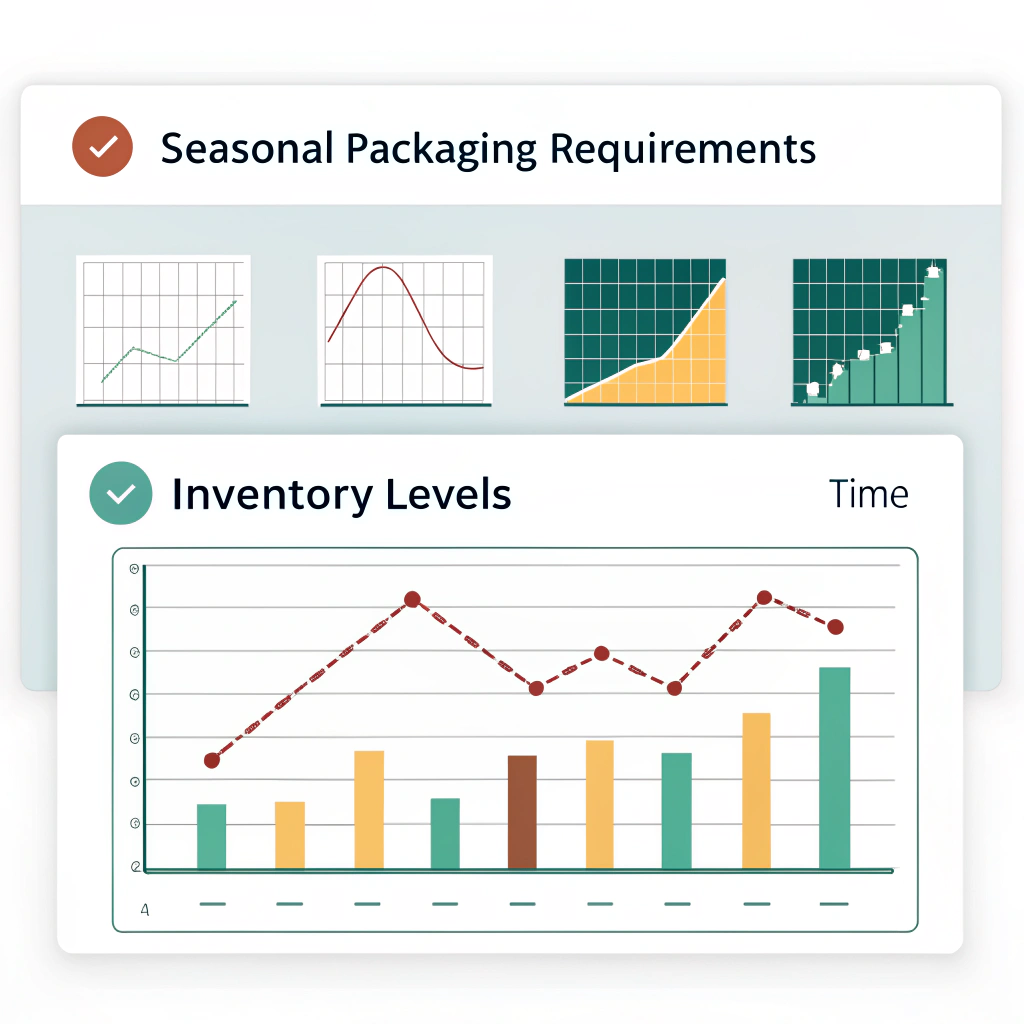Seasonal Inventory Planning for Packaging
Seasonal demand fluctuations can make or break packaging operations. Smart inventory planning anticipates these patterns, balances costs with availability, and ensures packaging materials are ready when needed. Effective seasonal planning requires understanding demand cycles, supplier capabilities, and financial impacts while building flexibility for unexpected changes.

Strategic seasonal planning aligns packaging inventory with predictable demand patterns throughout the year
Understanding Your Seasonal Patterns
Begin with thorough analysis of historical packaging usage across multiple years. Identify peak periods, seasonal variations, and gradual trends that affect packaging needs. Most businesses experience predictable cycles tied to holidays, weather, or industry-specific events.
Document monthly usage patterns for each packaging type, noting not just quantities but also seasonal design variations. Halloween packaging differs from Christmas materials, and back-to-school requirements vary from summer promotions. This granular analysis forms the foundation for accurate planning.
Consider external factors that influence your patterns: economic conditions, competitor actions, marketing campaigns, and industry trends. These variables can shift seasonal timing or intensity, requiring plan adjustments.
Building Accurate Demand Forecasts
Effective forecasting combines historical data with forward-looking insights. Use rolling averages to smooth anomalies while identifying legitimate trend changes. Incorporate planned marketing activities, new product launches, and expected market conditions into your projections.

Accurate demand forecasting combines historical data with future business plans and market insights
Collaborate with sales, marketing, and product teams to understand planned activities that affect packaging demand. New product launches, promotional campaigns, and seasonal marketing initiatives significantly impact packaging requirements beyond historical patterns.
Build scenarios for different demand levels: conservative, expected, and aggressive forecasts. This range helps determine optimal inventory levels that balance service levels with carrying costs.
Strategic Procurement Timing
Seasonal planning requires coordinating procurement with supplier capabilities and lead times. Order seasonal materials well ahead of peak periods, but balance early ordering with storage costs and cash flow impacts.
Negotiate volume commitments with suppliers for better pricing on seasonal orders. Many suppliers offer early-order discounts to level their production schedules. These arrangements can reduce costs while ensuring material availability.
Consider supplier capacity constraints during peak seasons. Popular materials may have extended lead times during busy periods, requiring earlier ordering or alternative specifications.
Inventory Level Optimization
Calculate optimal inventory levels by balancing carrying costs against stockout risks. Seasonal items require different strategies than year-round materials due to concentrated demand periods and limited selling windows.

Efficient warehouse organization separates seasonal packaging by time periods and demand patterns
For seasonal packaging, frontload inventory before peak periods rather than maintaining steady levels year-round. This approach minimizes carrying costs while ensuring availability when needed.
Build safety stock levels based on demand variability and supplier reliability. Seasonal patterns often show higher variability than steady-state demand, requiring larger safety buffers.
Cash Flow Management
Seasonal inventory planning significantly impacts cash flow. Large pre-season purchases tie up capital months before generating revenue. Plan financing needs and negotiate payment terms that align with revenue timing.
Consider supplier payment terms, early-payment discounts, and seasonal financing options. Some suppliers offer extended payment terms for early seasonal orders, improving cash flow alignment.
Monitor inventory turns and carrying costs carefully. Seasonal inventory should turn quickly during peak periods, but slow turns increase carrying costs substantially.
Managing Obsolescence Risk
Seasonal packaging faces higher obsolescence risk than standard materials. Design changes, color trends, and seasonal variations can make inventory unusable for future seasons.
Minimize obsolescence by ordering closer to need dates when possible, negotiating supplier buyback agreements, and designing flexible packaging that works across multiple seasons.
Consider generic seasonal designs over specific holiday themes. “Winter” packaging may have broader applications than “Christmas” materials, reducing obsolescence risk.
Cross-Seasonal Planning Strategies
Look for opportunities to use materials across multiple seasons. Spring pastels might work for Easter and Mother’s Day. Generic celebration themes can serve multiple holidays throughout the year.
Plan seasonal transitions carefully to minimize overlap inventory. Clear protocols for switching between seasonal designs prevent accumulation of unused materials.
Technology and Planning Tools
Leverage inventory management systems with seasonal planning capabilities. These tools can model different scenarios, track seasonal performance, and automate reorder points based on seasonal patterns.
Advanced planning systems integrate with sales forecasts, supplier lead times, and financial planning to optimize seasonal inventory decisions automatically.
Seasonal packaging inventory planning requires balancing multiple competing priorities: cost control, service levels, cash flow, and obsolescence risk. Success comes from understanding your unique patterns, building strong supplier relationships, and maintaining flexibility to adjust plans as conditions change.
